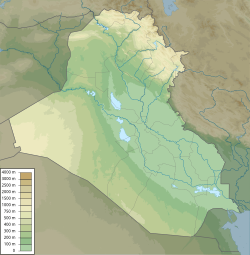
Back Mosoel Afrikaans Mosul ANG الموصل Arabic ܡܘܨܠ ARC الموصل ARZ Mosul AST Mosul Azerbaijani موصول AZB Мосул Bashkir Масул Byelorussian
Mosul
الموصل ܡܘܨܠ | |
|---|---|
Top to bottom, left to right: View over Tigris river, The Eastern Bank of Tigris River, Green Mosque, Mor Mattai Monastery, Old City of Mosul, Hatra, Nineveh Walls and Mosul Corniche | |
| Nickname(s): Nīnwē ܢܝ݂ܢܘܹܐ The Pearl of the North | |
| Coordinates: 36°20′N 43°08′E / 36.34°N 43.13°E | |
| Country | |
| Governorate | Nineveh |
| District | Mosul |
| Government | |
| • Type | Mayor–council government |
| • Body | Nineveh Governorate |
| • Mayor | Zuhair Al-Araji |
| Area | |
• Total | 180 km2 (70 sq mi) |
| Elevation | 223 m (732 ft) |
| Population (2023)[2] | |
• Total | 1,792,000 |
| • Density | 10,000/km2 (26,000/sq mi) |
| Demonym(s) | Mosuli Maslawi |
| Time zone | UTC+3 (AST) |
| Area code | 60 |
Mosul (/ˈmoʊsəl, moʊˈsuːl/ MOH-səl, moh-SOOL; Arabic: الموصل, romanized: al-Mawṣil, pronounced [alˈmawsˤil] ⓘ, locally [ɪlˈmoːsˤɪl]; Kurdish: مووسڵ, romanized: Mûsil;[3][4] Turkish: Musul; Syriac: ܡܘܨܠ, romanized: Māwṣil[5]) is a major city in northern Iraq, serving as the capital of Nineveh Governorate. It is the second largest city in Iraq overall after the capital Baghdad. Situated on the banks of Tigris, the city encloses the ruins of the ancient Assyrian city of Nineveh—once the largest city in the world—on its east side.[6]
Due to its strategic and central location, the city has traditionally served as one of the hubs of international commerce and travel in the region. It is considered as of the one of the historically and culturally significant cities of the Arab world. The North Mesopotamian dialect of Arabic commonly known as Moslawi is named after Mosul, and is widely spoken in the region. Together, with the Nineveh Plains, Mosul is a historical center of the Assyrians. The surrounding region is ethnically and religiously diverse; a large majority of the city is Arabs, with Kurds, Assyrians, Turkmens, Shabaks, and other minorities comprising the population. Sunni Islam is the largest religion, but there is a sizeable number of Christians and Yazidis, as well as adherents of other Islamic sects such as Shi'ites and Shabakis and formerly Jews.[7] Mosul and its surrounding region is significantly important in biblical history
During the invasion of Iraq, Mosul was captured by United States-led coalition forces in April 2003. Throughout the war, the city was subjected to attacks, bombings, and a sectarian civil war. After the withdrawal of American troops in 2011, an Islamist insurgency began, and the Islamic State started its territorial expansion. Mosul fell to ISIS in 2014, causing around 500,000 people to flee the city. Christians and Yazidis were persecuted, prompting a mass exodus of Assyrians. Much of the city's cultural heritage was destroyed in by the ISIS. With the help of an international intervention and support from the United States, the Iraqi Armed Forces successfully liberated the city. On 9 July 2017, prime minister Haider al-Abadi officially declared the city's liberation from the ISIS militants. Currently, the city is reviving its lost legacy, with help of foreign funds for reconstruction.
The metropolitan area has grown from the old city on the western side to encompass substantial areas on both the "Left Bank" (east side) and the "Right Bank" (west side), as locals call the two respective sides of the Tigris. Historically, essential products of the area included marble and oil. The region around Mosul is rich in oil reserves. Mosul is home to the University of Mosul and its renowned Medical College, one of the Middle East's largest educational and research centers. The city is also home to historic mosques, Christian sites, synagogues and Yazidi temples.
- ^ Gladstone, Philip (10 February 2014). "Synop Information for ORBM (40608) in Mosul, Iraq". Weather Quality Reporter. Retrieved 16 June 2014.
- ^ "Mosul, Iraq Metro Area Population 1950-2023". Macrotrends.
- ^ "Nêçîrvan Barzanî: Serxwebûn Mafê Gelê Kurd E" (in Kurdish). Voice of America. Retrieved 13 March 2020.
- ^ "ئەمساڵ كۆنسۆڵخانەى توركيا لە مووسڵ دووبارە دەكرێتەوە" (in Kurdish). Anadolu Agency. Retrieved 13 March 2020.
- ^ Thomas A. Carlson et al., "Mosul – ܡܘܨܠ " in The Syriac Gazetteer last modified June 30, 2014, http://syriaca.org/place/139.
- ^ Coker, Margaret (2017-12-10). "After Fall of ISIS, Iraq's Second-Largest City Picks Up the Pieces". The New York Times. ISSN 0362-4331. Retrieved 2021-04-25.
- ^ Dalley, Stephanie (1993). "Nineveh After 612 BC." Alt-Orientanlische Forshchungen 20. p.134.








